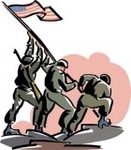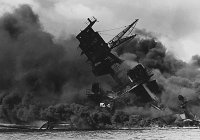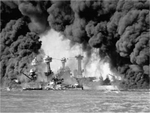
Worksheets and No Prep Teaching Resources
Reading Comprehension Worksheets
World War II
Pearl Harbor

World War II
 Worksheets and No Prep Teaching Resources Reading Comprehension Worksheets World War II Pearl Harbor |
 World War II |
| edHelper's suggested reading level: | grades 7 to 9 | |
| Flesch-Kincaid grade level: | 7.9 |
|
Pearl Harbor
By Jane Runyon |

|
 1 "Yesterday, December 7, 1941, a date which will live in infamy, the United States of America was suddenly and deliberately attacked by naval and air forces of the Empire of Japan." These are the words President Franklin Delano Roosevelt used to address the United States Congress on December 8, 1941. Every American within the sound of a radio heard his words. He used the word "infamy." That word refers to someone or something that will be remembered for a very long time. Unfortunately, it will be remembered in a bad way, not a good one. The United States had just suffered a devastating attack on its navy and air force.
1 "Yesterday, December 7, 1941, a date which will live in infamy, the United States of America was suddenly and deliberately attacked by naval and air forces of the Empire of Japan." These are the words President Franklin Delano Roosevelt used to address the United States Congress on December 8, 1941. Every American within the sound of a radio heard his words. He used the word "infamy." That word refers to someone or something that will be remembered for a very long time. Unfortunately, it will be remembered in a bad way, not a good one. The United States had just suffered a devastating attack on its navy and air force. |
Create Weekly Reading Books
Prepare for an entire week at once! |
| Leave your feedback on Pearl Harbor (use this link if you found an error in the story) |
 |
World War II
|
 |
Pearl Harbor
|
 |
High School Reading Comprehensions and High School Reading Lessons
|
 |
Social Studies
|
 |
United States
|
|
|
|
|
 | Fifty States Theme Unit |
 |
Document Based Activities |